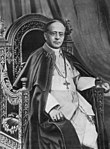Catholic resistance to Nazism
|
| Catholic resistors (clockwise L-R): Erich Klausener; Blessed August von Galen; Alfred Delp SJ; Claus von Stauffenberg; Bishop Konrad von Preysing; Saint Edith Stein; Jules-Géraud Saliège; Irena Sendlerowa of Zegota; Pope Pius XI; Hugh O'Flaherty |
Bishop August von Galen of Münster
Alfred Delp SJ
Konrad von Presying of Berlin
Saint Edith Stein
Jules-Géraud Saliège of Toulouse
Catholic resistance to Nazism was a component of German resistance to Nazism and of Resistance during World War II. The Church in Germany opposed the rise of Nazism, but attempted compromise when Hitler won power. From the outset of Nazi rule in 1933, issues emerged which brought the Church into conflict with the regime and persecution of the Church led Pope Pius XI to denounce the policies of the Nazi Government in the 1937 papal encyclical Mit brennender Sorge. His successor Pius XII faced the war years and provided intelligence to the Allies. Though Catholics fought on both sides in World War II and neither the Catholic nor Protestent churches as institutions were prepared to openly oppose the Nazi State, the churches provided the earliest and most enduring centres of systematic opposition to Nazi policies, and Christian morality and Nazi anti-Church policies motivated many German resistors and provided moral impetus for individuals in their efforts to overthrow Hitler.
An estimated one-third of German Catholic priests faced some form of reprisal from authorities and thousands of Catholic clergy and religious were sent to concentration camps. 400 Germans were among the 2,579 Catholic priests imprisoned in the clergy barracks at Dachau. While the head German bishop generally avoided confronting the regime, other bishops such as Preysing, Frings and Galen developed a Catholic critique of aspects of Nazism. Galen led Catholic protest against Nazi "euthanasia".
...
Wikipedia









